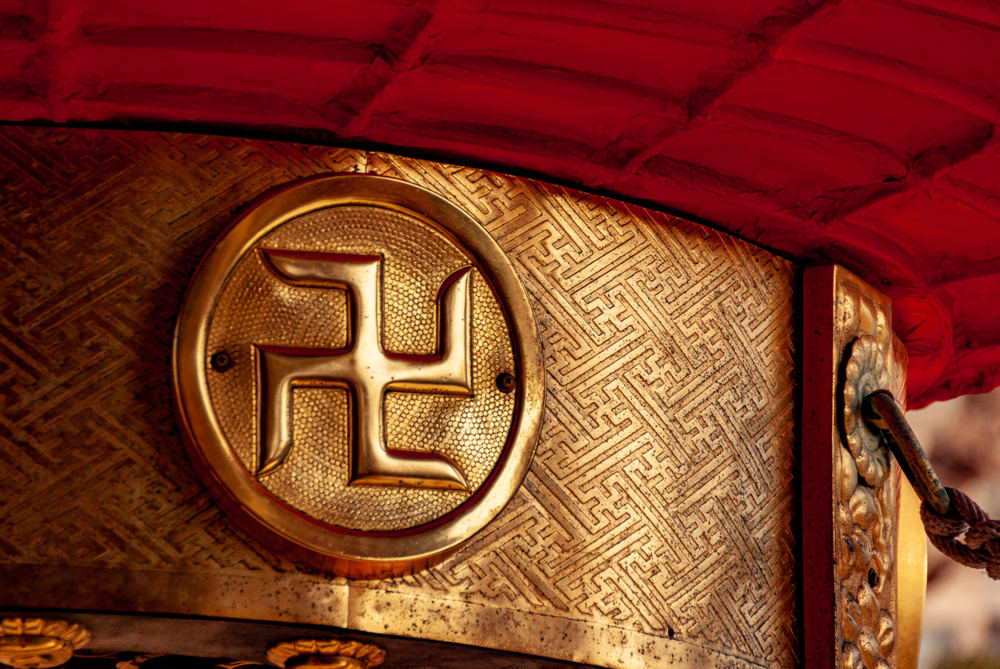
Would you want to live in a neighborhood named Swastika Acres? Probably not. As the Denver Post reports, residents of a Denver-area suburb faced this very problem. The locals called it Old Cherry Hills, but homeowners had seen its official name on land deeds for years. To rectify the problem, Cherry Hills Village’s city council voted to change the subdivision’s name to Old Cherry Hills.
One key detail in this tale is the original intent of the neighborhood’s builders. The Denver Swastika Land Company named the subdivision in 1908 after the familiar symbol used by various Indigenous cultures across the American Southwest. This story illustrates a terrible truth. While the swastika’s history begins in ancient civilizations, its modern meaning is a direct result of bigoted ideologies that threatened to extinguish an entire diaspora.
Faith and Good Fortune in Many Cultures
As the Holocaust Encyclopedia explains, the swastika appears in several older cultures across Europe and Asia. Our contemporary term comes from the Sanskrit word “svastika,” which translates to “good fortune” or “well-being.” The Conversation remarks on its geometrically balanced and pleasing shape, which illuminates its former cross-cultural appeal. Discovered in Indus Valley Civilization ruins, it takes on a wide range of meanings within religions across the Indian subcontinent:
- Buddhism: the footprints of the Buddha
- Hinduism: the opposites of light and dark
- Jainism: a symbol of the revered teacher Suparshvanatha
Swastikas are also found in Navajo culture, where they’re called “whirling logs” and symbolize good luck. They’re also emblazoned on Germanic and Viking artifacts, Mesopotamian coins, and Roman garment hems as well as Ashanti gold weights, fabrics, and pottery. Some medieval Christian churches and religious vestments bear the symbol, and it became a lucky emblem in Western nations during the 19th century.
Its Arrival and Use in Nazi Germany
The late 19th century was a time of historical discoveries and advancing scholarship. German archeologist Heinrich Schliemann excavated a site rumored to be ancient Troy during the 1880s. After uncovering swastikas on various Greek artifacts, he remembered similar designs found on items from pre-Christian German civilizations.
Both the Holocaust Encyclopedia and The Conversation discuss interpretations of Schliemann’s findings. Some concluded that both the Greeks and Germans shared an ancestor “Aryan” culture that once spanned Europe and Asia. The Encyclopedia Britannica discloses that modern scholars tend to reject this hypothesis, but it was seen as a significant concept during the late 19th and early 20th centuries.
Unfortunately, Germany’s growing nationalist movement saw in it the perfect opportunity to claim descent from a supposedly superior race. The Thule Society was the first to seize upon the swastika as a nationalist symbol, and Adolf Hitler co-opted it into the recognizable visual design. As the country fell under Nazi rule, this emblem went hand in hand with violently anti-Semitic ideology and policies. From public rallies to Hitler’s “Jewish solution,” the swastika symbolized a racist vision for a new world order.
The effects of these destructive philosophies are still felt today. As Time discloses, it has taken over 70 years for the worldwide Jewish population to return to pre-Holocaust levels. Survivors and their descendants observe Yom HaShoah, a day to commemorate the millions of Jewish people who died under this campaign of terror. In 2019, Yom HaShoah begins at sundown on May 1 and ends on May 2.
Can This Symbol Be Redeemed?
Cultural appropriation and nationalism are both hot topics in our current public discourse. Their intersection caused an auspicious religious symbol to gain a hateful legacy. Many nations now ban the display of swastikas, but this raises issues within cultures that lack inherent associations between these emblems and Nazism. As debate continues, civilizations still wrestle with the question of whether swastikas can ever be separated from their recent legacy.

